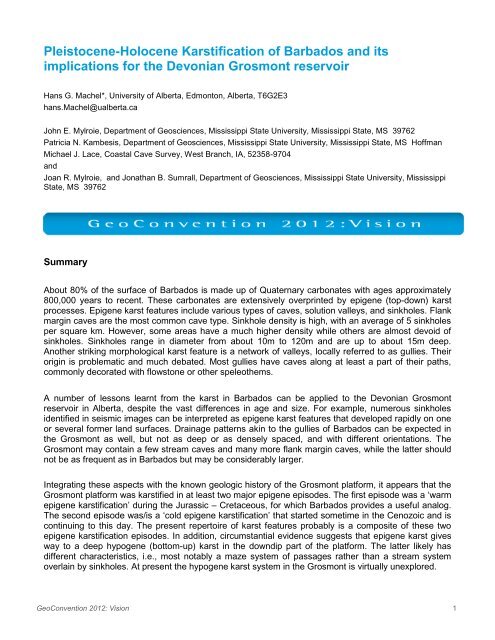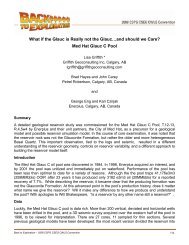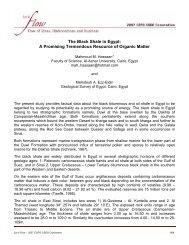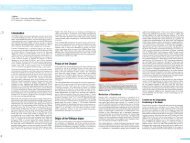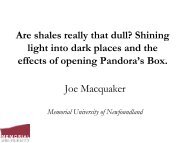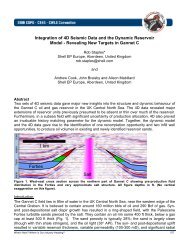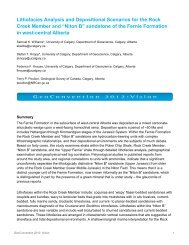Pleistocene-Holocene Karstification of Barbados and its implications ...
Pleistocene-Holocene Karstification of Barbados and its implications ...
Pleistocene-Holocene Karstification of Barbados and its implications ...
You also want an ePaper? Increase the reach of your titles
YUMPU automatically turns print PDFs into web optimized ePapers that Google loves.
<strong>Pleistocene</strong>-<strong>Holocene</strong> <strong>Karstification</strong> <strong>of</strong> <strong>Barbados</strong> <strong>and</strong> <strong>its</strong><br />
<strong>implications</strong> for the Devonian Grosmont reservoir<br />
Hans G. Machel*, University <strong>of</strong> Alberta, Edmonton, Alberta, T6G2E3<br />
hans.Machel@ualberta.ca<br />
John E. Mylroie, Department <strong>of</strong> Geosciences, Mississippi State University, Mississippi State, MS 39762<br />
Patricia N. Kambesis, Department <strong>of</strong> Geosciences, Mississippi State University, Mississippi State, MS H<strong>of</strong>fman<br />
Michael J. Lace, Coastal Cave Survey, West Branch, IA, 52358-9704<br />
<strong>and</strong><br />
Joan R. Mylroie, <strong>and</strong> Jonathan B. Sumrall, Department <strong>of</strong> Geosciences, Mississippi State University, Mississippi<br />
State, MS 39762<br />
Summary<br />
About 80% <strong>of</strong> the surface <strong>of</strong> <strong>Barbados</strong> is made up <strong>of</strong> Quaternary carbonates with ages approximately<br />
800,000 years to recent. These carbonates are extensively overprinted by epigene (top-down) karst<br />
processes. Epigene karst features include various types <strong>of</strong> caves, solution valleys, <strong>and</strong> sinkholes. Flank<br />
margin caves are the most common cave type. Sinkhole density is high, with an average <strong>of</strong> 5 sinkholes<br />
per square km. However, some areas have a much higher density while others are almost devoid <strong>of</strong><br />
sinkholes. Sinkholes range in diameter from about 10m to 120m <strong>and</strong> are up to about 15m deep.<br />
Another striking morphological karst feature is a network <strong>of</strong> valleys, locally referred to as gullies. Their<br />
origin is problematic <strong>and</strong> much debated. Most gullies have caves along at least a part <strong>of</strong> their paths,<br />
commonly decorated with flowstone or other speleothems.<br />
A number <strong>of</strong> lessons learnt from the karst in <strong>Barbados</strong> can be applied to the Devonian Grosmont<br />
reservoir in Alberta, despite the vast differences in age <strong>and</strong> size. For example, numerous sinkholes<br />
identified in seismic images can be interpreted as epigene karst features that developed rapidly on one<br />
or several former l<strong>and</strong> surfaces. Drainage patterns akin to the gullies <strong>of</strong> <strong>Barbados</strong> can be expected in<br />
the Grosmont as well, but not as deep or as densely spaced, <strong>and</strong> with different orientations. The<br />
Grosmont may contain a few stream caves <strong>and</strong> many more flank margin caves, while the latter should<br />
not be as frequent as in <strong>Barbados</strong> but may be considerably larger.<br />
Integrating these aspects with the known geologic history <strong>of</strong> the Grosmont platform, it appears that the<br />
Grosmont platform was karstified in at least two major epigene episodes. The first episode was a ‘warm<br />
epigene karstification’ during the Jurassic – Cretaceous, for which <strong>Barbados</strong> provides a useful analog.<br />
The second episode was/is a ‘cold epigene karstification’ that started sometime in the Cenozoic <strong>and</strong> is<br />
continuing to this day. The present repertoire <strong>of</strong> karst features probably is a composite <strong>of</strong> these two<br />
epigene karstification episodes. In addition, circumstantial evidence suggests that epigene karst gives<br />
way to a deep hypogene (bottom-up) karst in the downdip part <strong>of</strong> the platform. The latter likely has<br />
different characteristics, i.e., most notably a maze system <strong>of</strong> passages rather than a stream system<br />
overlain by sinkholes. At present the hypogene karst system in the Grosmont is virtually unexplored.<br />
GeoConvention 2012: Vision 1
Introduction<br />
<strong>Barbados</strong> is located at 13 o 10' north latitude, 59 o 35' west longitude, <strong>and</strong> is about 32 x 23 km in size.<br />
Overlying tectonically deformed siliciclastic sediments, about 80% <strong>of</strong> the surface <strong>of</strong> the isl<strong>and</strong> is made<br />
up <strong>of</strong> Quaternary carbonates with ages approximately 800,000 years to recent (Fig. 1: the siliciclastics<br />
are exposed in the Scotl<strong>and</strong> District). These carbonates are a few meters to about 120 m in thickness<br />
<strong>and</strong> form a series <strong>of</strong> terraces, which were deposited in response to an interplay <strong>of</strong> tectonic uplift <strong>and</strong><br />
eustatic sea level changes, with tectonic uplift ranging episodically from ~7 to 440 m per 100,000 years<br />
over the past 800,000 years.<br />
Caves<br />
The Quaternary carbonates <strong>of</strong> <strong>Barbados</strong> are extensively overprinted by epigene (top-down) karst<br />
processes. Epigene karst features include various types <strong>of</strong> caves, solution valleys (locally called<br />
gullies), <strong>and</strong> sinkholes. Genetically, <strong>Barbados</strong> has four types <strong>of</strong> natural caves: (1) stream caves formed<br />
by fresh-water dissolution; (2) flank margin caves formed by mixed freshwater-seawater dissolution<br />
(this particular form <strong>of</strong> cave formation may also be considered hypogene, i.e., bottom-up); (3) sea<br />
caves formed by seawater corrasion; <strong>and</strong> (4) hybrid caves that formed by more than one <strong>of</strong> the above<br />
processes. In addition, (5) there are numerous man-made ‘caves’ <strong>and</strong> tunnels dug for enhanced<br />
drainage after heavy rains. In most cases the mode <strong>of</strong> cave formation can be determined from cave<br />
sizes, passage dimensions, branching patterns, <strong>and</strong> from morphological features such as wall<br />
scalloping, bell holes, <strong>and</strong> solution pillars. Calcite speleothems have developed almost exclusively in<br />
stream <strong>and</strong> flank margin caves. Stream caves also contain variable amounts <strong>of</strong> talus (blocks up to<br />
many tons in weight fallen <strong>of</strong>f cave ro<strong>of</strong>s) <strong>and</strong> sediments (mainly mud <strong>and</strong> minor amounts <strong>of</strong> coarser<br />
debris) deposited by stream flow, whereas flank margin caves are almost devoid <strong>of</strong> such depos<strong>its</strong>.<br />
Given uplift rates <strong>and</strong> glacioeustasy, flank margin cave development has been extensive, pervasive,<br />
<strong>and</strong> rapid.<br />
Most caves in <strong>Barbados</strong> are hybrid caves, whereby glacioeustasy <strong>and</strong> tectonics caused cave-forming<br />
environments to overprint each other. Flank margin caves are the most common cave converted to the<br />
hybrid state as they are readily breached <strong>and</strong> modified by coastal wave processes (Fig. 2) <strong>and</strong>/or fresh<br />
water erosion. To date, we have mapped about 80 flank margin caves <strong>and</strong> estimate that their total<br />
number is in the hundreds. Most are but a few meters in diameter, but some are up to ~100m long <strong>and</strong><br />
~15 m in height.<br />
Fresh water stream caves are few but much larger. They are found in the upl<strong>and</strong> isl<strong>and</strong> interior.<br />
Harrison’s Cave has over 2 km <strong>of</strong> branched passages <strong>and</strong> is partially developed as a tourist site.<br />
Nearby Cole’s Cave (Fig. 3) is about the same length but undeveloped. There are at least two other yet<br />
shorter stream caves. The stream caves breach whatever other karst features <strong>and</strong>/or sedimentary<br />
boundaries are in their paths.<br />
Sinkholes<br />
The present carbonate-covered l<strong>and</strong> surface <strong>of</strong> the isl<strong>and</strong> is pockmarked by 2830 sinkholes, which<br />
amounts to about 5 sinkholes per square km on average. However, some areas have a much higher<br />
density while others are almost devoid <strong>of</strong> sinkholes (Fig. 4). The reasons for this uneven distribution are<br />
under investigation. Sinkholes range in diameter from about 10m to 120m <strong>and</strong> are up to about 15m<br />
deep, <strong>and</strong> cave entrances are visible in some <strong>of</strong> them (Fig. 5). Most sinkholes formed over the last<br />
500,000 years, attesting to their relatively rapid formation.<br />
GeoConvention 2012: Vision 2
Gullies<br />
Another striking morphological karst feature is dozens <strong>of</strong> branching valleys, locally referred to as<br />
gullies. Their origin is problematic <strong>and</strong> much debated. From the air, the gullies resemble a network <strong>of</strong><br />
narrow creeks in the highl<strong>and</strong>s, which merge progressively to fewer <strong>and</strong> wider rivers that run toward<br />
the northern, western, <strong>and</strong> southern coastlines (Fig. 6). Although dry over most <strong>of</strong> the year, the gullies<br />
form an important part <strong>of</strong> the surface drainage system <strong>of</strong> the isl<strong>and</strong>. They quickly flood <strong>and</strong> carry huge<br />
amount <strong>of</strong> water during heavy rainfalls. The origin <strong>of</strong> the gullies was complex. Sinkholes can connect to<br />
elongate solution features called ‘solution valleys’, <strong>and</strong> at least some <strong>of</strong> <strong>Barbados</strong>’ gullies may have<br />
formed in this way. Most gullies, however, have a hybrid origin <strong>and</strong> probably formed by the combined<br />
effects <strong>of</strong> surface erosion, subsurface dissolution, global sea level fluctuations, <strong>and</strong> local tectonic uplift.<br />
Most gullies have caves along at least a part <strong>of</strong> their paths, commonly decorated with flowstone or<br />
other speleothems (Fig. 7). Most <strong>of</strong> these caves are flank margin caves overprinted by fresh water<br />
speleogenesis, later cut open by fresh water erosion.<br />
Application to the Grosmont reservoir<br />
A number <strong>of</strong> lessons learnt from the karst in <strong>Barbados</strong> can be applied to the Devonian Grosmont<br />
reservoir in Alberta, despite the vast differences in age <strong>and</strong> size. For example, numerous sinkholes<br />
identified in seismic images can be interpreted as epigene karst features that developed rapidly on one<br />
or several former l<strong>and</strong> surfaces. Also, at least some sinkholes can be expected to provide fluid<br />
passageways across reservoir levels. Drainage patterns akin to the gullies <strong>of</strong> <strong>Barbados</strong> can be<br />
expected in the Grosmont as well, but not as deep or as densely spaced, <strong>and</strong> with different<br />
orientations. The Grosmont may contain a few stream caves <strong>and</strong> many more flank margin caves, while<br />
the latter should not be as frequent as in <strong>Barbados</strong> but may be considerably larger, considering the<br />
tectonically relatively stable position <strong>of</strong> the Grosmont platform. However, recognition <strong>of</strong> the mode <strong>of</strong><br />
cave formation probably will remain elusive in the Grosmont at least for the relatively small caves. This<br />
is because a genetic interpretation requires human inspection <strong>of</strong> cave wall morphology, which is<br />
impossible in the Grosmont reservoir.<br />
Integrating these aspects with the known geologic history <strong>of</strong> the Grosmont platform, it appears that the<br />
Grosmont platform was karstified in at least two major epigene episodes. The first episode was a ‘warm<br />
epigene karstification’ during the Jurassic – Cretaceous, for which <strong>Barbados</strong> provides a useful analog.<br />
The second episode was/is a ‘cold epigene karstification’ that started sometime in the Cenozoic <strong>and</strong> is<br />
continuing to this day. The present repertoire <strong>of</strong> karst features probably is a composite <strong>of</strong> these two<br />
epigene karstification episodes. In addition, circumstantial evidence suggests that epigene karst gives<br />
way to a deep hypogene (bottom-up) karst in the downdip part <strong>of</strong> the platform. The latter likely has<br />
different characteristics, i.e., most notably a maze system <strong>of</strong> passages rather than a stream system<br />
overlain by sinkholes. At present the hypogene karst system in the Grosmont is virtually unexplored.<br />
Acknowledgements<br />
This research is ongoing. It is supported by a Discovery Grant to HGM from the Natural Sciences <strong>and</strong><br />
Engineering Research Council <strong>of</strong> Canada (NSERC). Richard Goddard <strong>and</strong> John Knox provided helpful<br />
hints regarding locating some caves that only ‘the locals’ know.<br />
References<br />
GeoConvention 2012: Vision 3
Machel, H.G., 1999, Geology <strong>of</strong> <strong>Barbados</strong>: A Brief Account <strong>of</strong> the Isl<strong>and</strong>'s Origin <strong>and</strong> Its Major Geological Features. <strong>Barbados</strong><br />
Museum <strong>and</strong> Historical Society, The Garrison, St. Michael, <strong>Barbados</strong>, 52 pp.<br />
Machel, H.G., 2009, Caves <strong>of</strong> <strong>Barbados</strong> - Wonders <strong>and</strong> dangers underground: The <strong>Barbados</strong> Advocate, March-01-2009, 33-<br />
40.<br />
Machel, H.G., 2011, The geology <strong>of</strong> <strong>Barbados</strong> - a little paradise in <strong>its</strong> own right. In: Carrington, C.M.S. (ed.): Preserving<br />
Paradise. <strong>Barbados</strong> Museum <strong>and</strong> Historical Society, 13-51.<br />
Machel, H.G.., Kambesis, P.N., Lace, M..J., Mylroie, J.R., Mylroie, J.E., <strong>and</strong> Sumrall, J.B., 2010, Caves <strong>of</strong> <strong>Barbados</strong>. The 15 th<br />
Symposium on the Geology <strong>of</strong> the Bahamas <strong>and</strong> Other Carbonate Regions. June 17- June 21 2010. Gerace Research Center,<br />
San Salvador, Bahamas, Abstracts with Program, p. 29-30.<br />
Machel, H.G., Sumrall, J.B., Kambesis, P.N., Mylroie, J.R., Mylroie, J.E., <strong>and</strong> Lace, M.J., 2011, Multiple cave types in Miocene<br />
<strong>and</strong> <strong>Pleistocene</strong> carbonates <strong>of</strong> <strong>Barbados</strong>, West Indies. Karst Water Institute, Special Meeting. Billings, Montana, August 6-9,<br />
2011.<br />
Mylroie, J. R., Mylroie, J. E., Kambesis, P. N., Lace, M. J., Machel, H. G., <strong>and</strong> Sumrall, J. B., 2010, Cave <strong>and</strong> Karst<br />
Reconnaissance <strong>of</strong> <strong>Barbados</strong>: Program, National Speleological Society Annual Meeting, p. 44 - 45.<br />
Mylroie, J. R., Mylroie, J. E., Kambesis, P. N., Lace, M. J., Machel, H. G., <strong>and</strong> Sumrall, J. B., 2010, Geologic Controls <strong>of</strong> Cave<br />
Development, <strong>Barbados</strong>: Program, National Speleological Society Annual Meeting, p. 49.<br />
Mylroie, J.R., Mylroie, J.E., Sumrall, J.B., Machel, H.G., Kambesis, P.N., Lace, M..J., 2010, Origin <strong>of</strong> <strong>Barbados</strong> gully system:<br />
overprinting <strong>of</strong> dissolution <strong>and</strong> surface erosion. The 15 th Symposium on the Geology <strong>of</strong> the Bahamas <strong>and</strong> Other Carbonate<br />
Regions. June 17- June 21 2010. Gerace Research Center, San Salvador, Bahamas, Abstracts with Program, p. 27-28.<br />
Schellmann, G. <strong>and</strong> Radtke, U., 2004, A revised morpho- <strong>and</strong> chronostratigraphy <strong>of</strong> the Late <strong>and</strong> Middle <strong>Pleistocene</strong> coral reef<br />
terraces on Southern <strong>Barbados</strong> (West Indies). Earth Science Reviews, v. 64, 157-187.<br />
W<strong>and</strong>elt, B. , 2000, Geomorphologische Detailkartierung und chronostratigraphische Gliederung der quartaeren Korallanriffe<br />
auf <strong>Barbados</strong> (West Indies) unter besonderer Beruecksichtigung des Karstformenschatzes. PhD. Thesis, University <strong>of</strong><br />
Cologne, Germany, unpublished.<br />
GeoConvention 2012: Vision 4
Fig. 1: Map <strong>of</strong> <strong>Barbados</strong>, showing the major geologic un<strong>its</strong> <strong>and</strong> other significant features. Modified from Machel, 1999.<br />
GeoConvention 2012: Vision 5
Fig. 2: Flank margin cave near North Point <strong>of</strong> the isl<strong>and</strong>, cut open by cliff erosion.<br />
Fig. 3: Incomplete survey map <strong>of</strong> Cole’s Cave, the second longest stream cave <strong>of</strong> <strong>Barbados</strong>. Additional passages measuring<br />
several hundred meters have yet to be mapped.<br />
GeoConvention 2012: Vision 6
Fig. 4: Distribution <strong>of</strong> sinkholes, as mapped by W<strong>and</strong>elt (2000).<br />
Fig. 5: Sinkhole with cave opening in the Lower Estates, located in the Middle Coral Rock Terrace.<br />
GeoConvention 2012: Vision 7
Fig. 6: Overview map <strong>of</strong> gully system in <strong>Barbados</strong>. From Schellmann <strong>and</strong> Radke (2004).<br />
Fig. 7: Large flank margin cave cut open by fresh water erosion. Jack-in-the-Box gully. Person for scale.<br />
GeoConvention 2012: Vision 8


